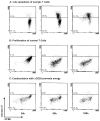Anergy induction by dimeric TCR ligands
- PMID: 11290814
- PMCID: PMC3414419
- DOI: 10.4049/jimmunol.166.8.5279
Anergy induction by dimeric TCR ligands
Abstract
T cells that recognize particular self Ags are thought to be important in the pathogenesis of autoimmune diseases. In multiple sclerosis, susceptibility is associated with HLA-DR2, which can present myelin-derived peptides to CD4(+) T cells. To generate molecules that target such T cells based on the specificity of their TCR, we expressed a soluble dimeric DR2-IgG fusion protein with a bound peptide from myelin basic protein (MBP). Soluble, dimeric DR2/MBP peptide complexes activated MBP-specific T cells in the absence of signals from costimulatory or adhesion molecules. This initial signaling through the TCR rendered the T cells unresponsive (anergic) to subsequent activation by peptide-pulsed APCs. Fluorescent labeling demonstrated that anergic T cells were initially viable, but became susceptible to late apoptosis due to insufficient production of cytokines. Dimerization of the TCR with bivalent MHC class II/peptide complexes therefore allows the induction of anergy in human CD4(+) T cells with a defined MHC/peptide specificity.
Figures






References
-
- Zamvil SS, Steinman L. The T lymphocyte in experimental allergic encephalomyelitis. Annu Rev Immunol. 1990;8:579. - PubMed
-
- Steinman L. Multiple sclerosis: a coordinated immunological attack against myelin in the central nervous system. Cell. 1996;85:299. - PubMed
-
- Goverman J, Woods A, Larson L, Weiner LP, Hood L, Zaller DM. Transgenic mice that express a myelin basic protein-specific T cell receptor develop spontaneous autoimmunity. Cell. 1993;72:551. - PubMed
-
- McDevitt HO. The role of MHC class II molecules in susceptibility and resistance to autoimmunity. Curr Opin Immunol. 1998;10:677. - PubMed
-
- Nepom GT, Erlich H. MHC class-II molecules and autoimmunity. Annu Rev Immunol. 1991;9:493. - PubMed
Publication types
MeSH terms
Substances
Grants and funding
LinkOut - more resources
Full Text Sources
Other Literature Sources
Research Materials
Miscellaneous

